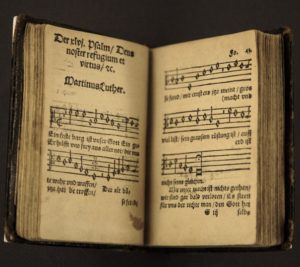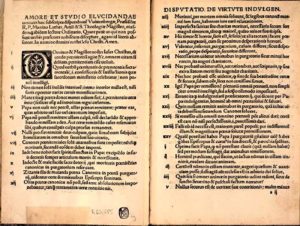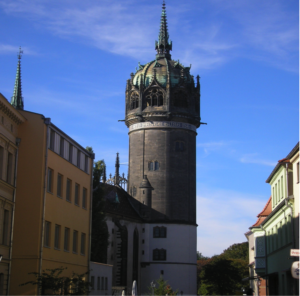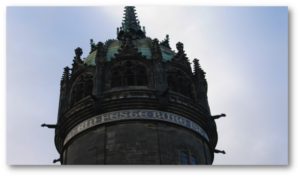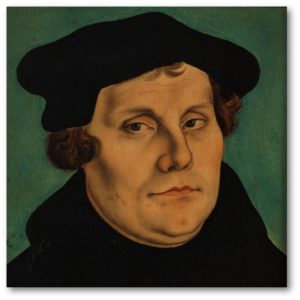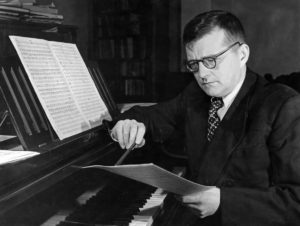
The Reformation – A Visual Introduction
The following article was written by Dennis L. Paulson to accompany the DSSO’s slideshow of images introducing the Reformation, which went along with our performance of Mendelssohn’s Symphony No.5
“Startled by the Clanging of a Bell”
Dennis L. Paulson
Accompanying the DSSO’s performance of the final movement of Felix Mendelssohn’s Reformation Symphony this evening is a visual collage of images drawn from the Renaissance and Reformation era of the 15th and 16th centuries, as the world observes the 500th anniversary of the Reformation movement in Western Christianity. It is a pictorial reflection on Martin Luther’s famous hymn, “Ein Feste Burg Ist Unser Gott”—which is the main theme of the fourth movement of Mendelssohn’s symphony.
For most people, probably their primary mental visualization of the events that set off the Reformation 500 years ago is the image of a German monk named Martin Luther wielding a hammer to nail a placard to a church door. That archetypal image—the so-called “posting” of the 95 Theses on Indulgences on the door of the Castle Church in Wittenberg, Saxony on October 31, 1517—is not among the images that will be seen in this pictorial collection, though it has been depicted countless times.
That is partly because it is so familiar; but also because it may be as much legend as fact, and because it has so often been used over the past five centuries for inflammatory, sensationalist, and provocative purposes, intended to evoke past inter-religious animosity and strife, and to perpetuate mutual hostility and reproach between faith communities—often with tragic political, social, and even military consequences.
Over the past fifty years or so, some historians have called into question the historical accuracy of the claim that on the Eve of All Saints Day in 1517, the Augustinian monk and biblical studies professor Martin Luther went to the door of the Castle Church in the university town of Wittenberg, hammer in hand, to nail a poster bearing his 95 statements for scholarly disputation to the church door—which supposedly served as a sort-of university “bulletin board.” Space does not allow us to get into the details of the present-day historical disputation over Luther’s disputation. Suffice it to say that we know for certain that on that date Luther mailed the 95 Theses protesting the sale of papal “indulgences” in Germany to Archbishop Albrecht of Mainz, who had authorized the sale in his realms.
 We know this because we have the cover letter Luther wrote in his own hand and dated that day. What we do not know for certain is whether, in fact, he nailed the theses to the church door—because neither Luther nor anyone else who was there at the time ever publicly said that he did. While it was standard practice in the university at the time to post such notices of scholarly debate on all the church doors of Wittenberg, it cannot be confirmed either that Luther did so in person or that it took place on that now-momentous date. So, regardless of whether Luther nailed the 95 Theses to the church door or simply mailed them to Archbishop Albrecht, the “posting” of the 95 Theses has gone down in history as the event that set off the Reformation.
We know this because we have the cover letter Luther wrote in his own hand and dated that day. What we do not know for certain is whether, in fact, he nailed the theses to the church door—because neither Luther nor anyone else who was there at the time ever publicly said that he did. While it was standard practice in the university at the time to post such notices of scholarly debate on all the church doors of Wittenberg, it cannot be confirmed either that Luther did so in person or that it took place on that now-momentous date. So, regardless of whether Luther nailed the 95 Theses to the church door or simply mailed them to Archbishop Albrecht, the “posting” of the 95 Theses has gone down in history as the event that set off the Reformation.
From this seemingly-innocuous event flowed unforeseen consequences that continue to reverberate today, five centuries later. No one was more surprised by what unfolded in the aftermath than was Martin Luther himself. In his definitive 1950 biography of Martin Luther, entitled Here I Stand, the American church historian Roland Bainton wrote:
Luther took no steps to spread his theses among the people. He was merely inviting scholars to dispute and dignitaries to define, but others surreptitiously translated the theses into German and gave them to the press. In short order they became the talk of Germany. What [the 20th century Swiss theologian] Karl Barth said of his own unexpected emergence as a reformer could be said equally of Luther, that he was like a man climbing in the darkness a winding staircase in the steeple of an ancient cathedral. In the blackness he reached out to steady himself, and his hand laid hold of a rope. He was startled to hear the clanging of a bell.
Perhaps in our time, as long-separated religious communities seek greater reconciliation, that image of being startled by the clanging of a bell in the church tower might serve as an alternative image for the initiating event of the Reformation 500 years ago; for that clanging bell summons us to pay attention once again.
So, while this pictorial compilation does not include the famous though controversial image of Martin Luther nailing his poster to the church door, it does include historical portraits of places, persons, and publications of the Renaissance and Reformation era. The opening images evoke the text and music of Martin Luther’s famous Reformation hymn, “A Mighty Fortress Is Our God,” culminating in a now-famous portrait of Luther, painted by Luther’s friend and Wittenberg’s resident painter and engraver, Lucas Cranach the Elder. Then we are reminded that the Reformation did not really begin with Luther, but with precursors over a century earlier—including John Wycliffe in England and Jan Hus in Bohemia and their followers. We are also reminded that the rapid dissemination of Luther’s writings, which fueled the emerging Reformation movement, would not have been possible without the invention by Johannes Gutenberg in the mid-15th century of moveable type and mass printing. That so-called “Gutenberg Revolution” in mass communications technology also contributed to the broad rebirth of art, culture, and classical literature and learning in western Europe from the 14th to the 17th centuries that became known as the Renaissance. The Reformation emerged from and was part and parcel of the Renaissance; so, we cannot fully grasp the significance of the Reformation and its continuing consequences without seeing it in this wider cultural context. Accordingly, we will see images from some of the iconic figures of Renaissance art—including the prototypical “Renaissance man,” Leonardo Da Vinci; his equally-famous contemporary, Michelangelo Buonarotti; and others, including Albrecht Dürer, Matthias Grünewald, Raphael, and Lucas Cranach the Elder.
We are also reminded that the religious, social, and political situation at the time Luther emerged on the scene was one of effervescent ferment and simmering turbulence that was ripe and ready for radical transformation, and that, as always, the forces defending the status quo were very strong. That the movement for reform in Western Christianity should have been provoked by a previously-unknown monk and professor from a relatively obscure university town in Saxony, however, was highly unexpected. Again, space does not allow us to get into the details of the immediate circumstance that aroused Luther’s impassioned protest in the 95 Theses: the promulgation of the so-called “Peter’s Indulgence”, which had been authorized by Pope Leo X in 1515 for the reconstruction of St. Peter’s Basilica in Rome. Luther came to see that the overblown preaching that accompanied the promotion of the papal indulgence in nearby territories was both a pastoral and theological distortion of the gifts of God’s grace offered in the church’s Sacrament of Penance. A famous little ditty attributed to the primary indulgence preacher, the Dominican friar Johann Tetzel, went: “As soon as the coin in the coffer rings, the soul to heaven springs.” Into the fertile soil of these abuses and the religious, social, and cultural ferment of the times Luther cast the seed of the gospel of peace with God through Christ alone. That seed would ultimately bear fruit in the broad movement of church renewal known as the Reformation—though unfortunately it resulted in the rending of church unity that endures to this day.
In this visual meditation, then, we will see images of many of the persons, places, and events of that turbulent time—including both political and religious figures, such as Luther’s prince, the Elector Frederick the Wise, and Archbishop Albrecht of Mainz, to whom Luther first sent his 95 Theses. We will also see pictures of Luther’s dramatic appearance before the Holy Roman Emperor, Charles V, at the Imperial Diet at Worms in 1521, and of his subsequent exile at the Wartburg Castle, where he began the translation of the Bible into German. We will see portraits of Luther’s colleagues at Wittenberg and fellow Protestant reformers from throughout Europe, as well as the wedding portraits painted by Cranach of Luther and his wife, Katharina von Bora, who were married in 1525. Near the conclusion, we will see the superb three-fold Cranach altarpiece that adorns the altar of the Stadtkirche in Wittenberg, where Luther regularly preached, pointing always to Christ crucified. Finally, we return with Mendelssohn’s music to an early printing of the tune and text of Luther’s great hymn, “A Mighty Fortress,” whose final stanza confidently proclaims:
God’s Word forever shall abide, no thanks to foes who fear it;
For God himself fights by our side, with weapons of the Spirit.
Were they to take our house, goods, honor, child, or spouse,
Though life be wrenched away, they cannot win the day.
The kingdom’s ours forever!
